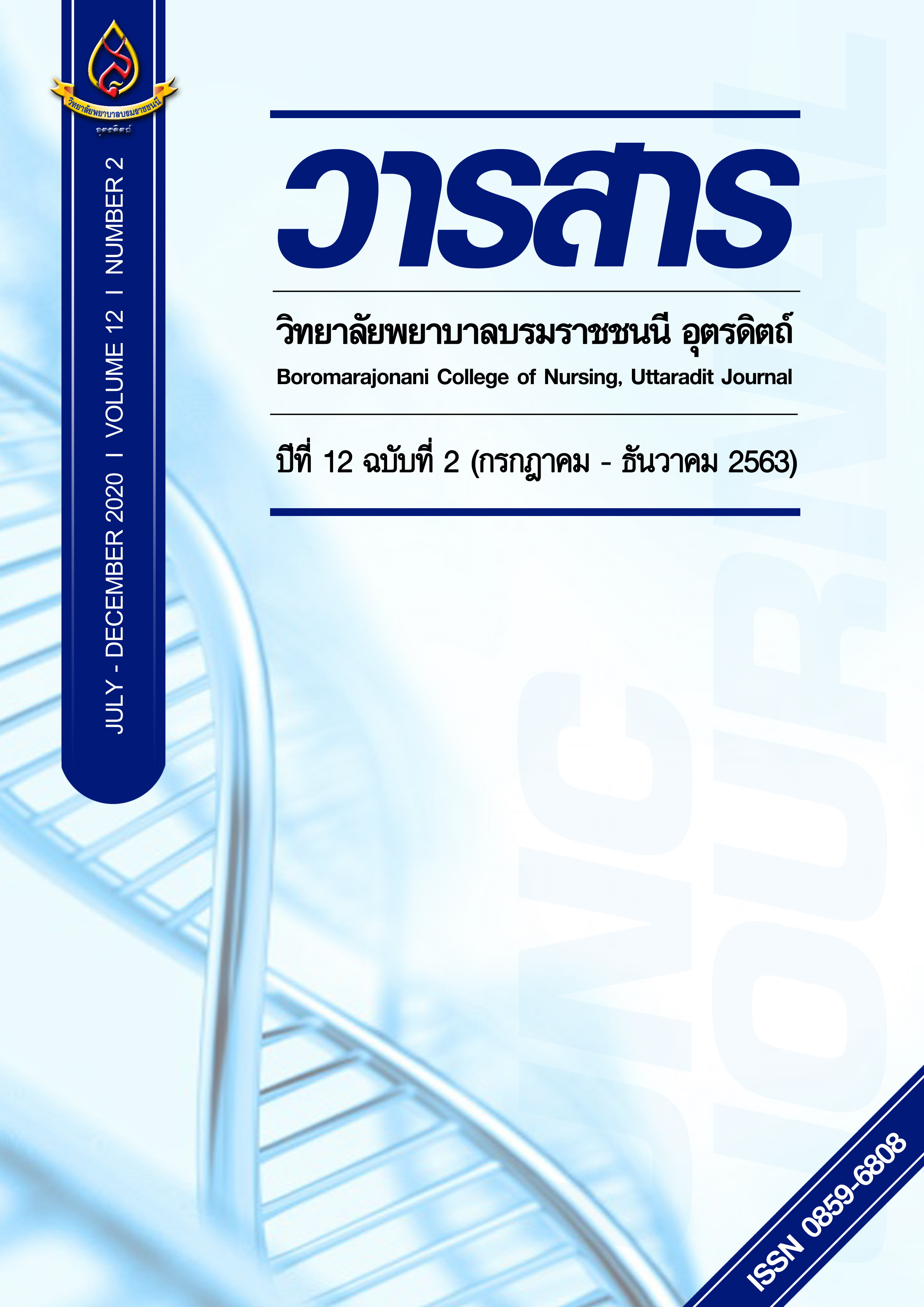ผลของโปรแกรมการจัดการตนเองต่อพฤติกรรมสุขภาพ และระดับความดันโลหิตของกลุ่มเสี่ยงโรคความดันโลหิตสูง โรงพยาบาลส่งเสริมสุขภาพตำบลปากห้วยอ้อย จังหวัดแพร่
Main Article Content
บทคัดย่อ
การวิจัยกึ่งทดลองแบบสองกลุ่มวัดก่อนและหลังการทดลองครั้งนี้ มีวัตถุประสงค์เพื่อศึกษาผลของโปรแกรมการจัดการตนเองต่อพฤติกรรมสุขภาพและระดับความดันโลหิตของกลุ่มเสี่ยงโรคความดันโลหิตสูงโรงพยาบาลส่งเสริมสุขภาพตำบลปากห้วยอ้อย จังหวัดแพร่ กลุ่มตัวอย่างเป็นกลุ่มเสี่ยงโรคความดันโลหิตสูง เลือกกลุ่มตัวอย่างแบบเจาะจงตามเกณฑ์จำนวน 52 คน แบ่งเป็นกลุ่มทดลองและกลุ่มควบคุม กลุ่มละ 26 คน ระยะเวลาในการทดลอง 12 สัปดาห์ เครื่องมือที่ใช้ประกอบด้วย โปรแกรมการจัดการตนเองสำหรับกลุ่มเสี่ยงโรคความดันโลหิตสูง คู่มือการจัดการตนเองสำหรับกลุ่มเสี่ยงโรคความดันโลหิตสูง แบบบันทึกพฤติกรรมสุขภาพ สื่อวีดิทัศน์ รูปภาพโปสเตอร์ เครื่องวัดความดันโลหิต และแบบสอบถามเกี่ยวกับความเชื่อด้านสุขภาพและพฤติกรรมสุขภาพ วิเคราะห์ข้อมูลโดยใช้ค่าความถี่ ร้อยละ ค่าเฉลี่ย ส่วนเบี่ยงเบนมาตรฐาน และสถิติ t-test กำหนดนัยสำคัญทางสถิติ .05
ผลการศึกษา พบว่า 1) ภายหลังได้รับโปรแกรมฯ กลุ่มทดลองมีคะแนนเฉลี่ยพฤติกรรมสุขภาพ และระดับความดันโลหิตสูงกว่าก่อนได้รับโปรแกรมฯ อย่างมีนัยสำคัญทางสถิติที่ .05 คะแนนเฉลี่ยพฤติกรรมสุขภาพสูงกว่าก่อนการทดลอง และค่าเฉลี่ยระดับความดันโลหิตต่ำกว่าก่อนการทดลอง 2) ภายหลังได้รับโปรแกรมฯ กลุ่มทดลองกับกลุ่มควบคุมมีคะแนนเฉลี่ยพฤติกรรมสุขภาพ และระดับความดันโลหิตแตกต่างกัน อย่างมีนัยสำคัญทางสถิติที่ .05 โดยกลุ่มทดลองมีคะแนนเฉลี่ยพฤติกรรมสุขภาพสูงกว่ากลุ่มควบคุม และค่าเฉลี่ยความดันโลหิตลดลงกว่ากลุ่มควบคุม แสดงให้เห็นถึงกลุ่มทดลองมีการจัดการตนเองได้ดีกว่าเนื่องจากโปรแกรมการจัดการตนเองมีกระบวนการตั้งเป้าหมาย กำหนดกิจกรรมในการปฏิบัติ เช่น การติดตามตนเอง การประเมินตนเอง การเสริมแรงตนเอง ทำให้มีความตั้งใจที่จะเปลี่ยนแปลงสุขภาพตนเองในทางที่ดี
Article Details
บทความหรือข้อคิดเห็นใดใดที่ปรากฏในวารสารวิจัยการพยาบาลและวิทยาศาสตร์สุขภาพ เป็นวรรณกรรมของผู้เขียน ซึ่งบรรณาธิการหรือสมาคมศิษย์เก่า ไม่จำเป็นต้องเห็นด้วย และบทความที่ได้รับการตีพิมพ์เผยแพร่ถือเป็นลิขสิทธิ์ของวารสารวิจัยการพยาบาลและวิทยาศาสตร์สุขภาพ
เอกสารอ้างอิง
Boonnuch, C.; et al. (2011). Sample size in Quantitative Research. Retrieved (2020, October 15) from http://www1.si.mahidol.ac.th/km/sites/default/files/ sample_size_0.pdf. (in Thai).
Bureau of Non-communicable Diseases, Department of Disease Control, Ministry of Public Health. (2015). News video and public relations. Retrieved (2020, October 15) from https://ddc.moph.go. th/newsvdo.php. (in Thai).
Coates, V. E. & Boore, J. R. (1995). Self-management of chronic illness implication for nursing. International Journal Nursing, 32,628-640.
Dongbo, F.; et al. (2003). Implementation and quantitative evaluation of chronic diseasself-management program in Shanghai. China: randomized controlled trial. Bull Word Health Organ, 81, 174-182.
Gunnasud, P. (1999). Statistics for behavioral science research (3rd ed.). Bangkok: Chulalongkorn University. (in Thai).
Health Education Division, Department of Health Service Support, Ministry of Public Health. (2013). Health behavior surveillance system for risk behavior changing of normal groups/risk groups/diabetes mellitus patients/hypertensive patients in Thailand: policy to practice for primary health care. Retrieved (2020, July 10) from www.hed.go.th (in Thai).
Jekel, J., Elmore, JG., Katz, DL., &Wild, D. (2007). Epidemiology, biostatistics and preventive medicine and public health. Philadelphia: Elsevier Health Science.
Kanfer, F. H., & Gaelick-Buys, L. (1991). Self-management methods. In F. Kanfer & A. Goldstein (Eds.). Helping
People Change: A Textbook of Methods (4th ed). New York: Pergamon Press.
Nunnally, J. C. (1978). Psychometric theory (3rd ed.). New York: McGraw-Hill.
Pak Huaioi Health Promoting Hospital. (2015). Database hosXP_PCU program. Phrae: N.P.
Polit, D.F. & Beck, C.T. (2008). Nursing research: generating and assign evidence for nursing practice. 8th ed. Philadelphia: Lippincott.
Pomchan, S. (2008). Health promoting behaviors among hypertension patients at the Phisalee hospitai, Nakhon Sawan Province. Chiangmai University, Chiangmai. (in Thai).
Riegel, B., Carlson, B., &Glaser, D. (2000). Development and testing of a clinical tool measuring self-management of heart failure. Heart & Lung, 29(1), 4-15.
Rongkwang Hospital. (2015). Medical records. Phrae: N.P. (in Thai).
Strategic and Planning Group, Office of the Permanent Secretary, Ministry of Public Health. (2011). Public health statistics 1998-2010. Retrieved (2020, October 15) from http://bps.moph.go.th (in Thai)
Strategic and Planning Group, Office of the Permanent Secretary, Ministry of Public Health. (2012). National health development plan during the eleventh national economic and Social Development Plan (2012 - 2016). Retrieved (2020, October 15) from http://bps.moph.go.th/ sites/default/ files/plan11_0.pdf (in Thai).
Strategic and Planning Group, Office of the Permanent Secretary, Ministry of Public Health. (2013). Number and rate of hypertensive patients. Retrieved (2020, October 15) from http://www.thaincd.com/2016/mission/documents.php?tid=32&gid=1-020 (in Thai)
Strategic and Planning Group, Office of the Permanent Secretary, Ministry of Public Health. (2013). Indicators strategy and data storage guidelines for Ministry of Public Health fiscal year 2013. Retrieved (2020, October 15) from http://www.kaset-hospital.org/ (in Thai)
_ Thai hypertension society. (2015). Thai guidelines on the treatment of hypertension 2012 update 2015. Retrieved (2020, October 15) from http://www.thaihypertension.org/files/GL%20HT%202015.pdf (in Thai).
Thatsaeng, B. (2011). Effects of a self-management supporting program on self-management behaviors and blood pressure among elders with dyslipidemia. (PhD’s thesis). Chiangmai University, Chiangmai. (in Thai).
Wangwonsin, A., Phetphum, J. & Sangouam, S. (2018). Factors influenced with self management development behaviors among type 2 diabetes mellitus patients in one health region. Research and Health System Journal, 11(2), 397-405. (in Thai).
Wongpiriyayothar, A., Buitee, S., Chamusr, S., Meethien, N. & Pitaksanurak, V. (2005). The effect of educative supportive nursing on knowledge, self-Care behaviors and health condition among heart failure patients. (PhD’s thesis). MahasaraKham University, MahasaraKham (in Thai).
World Health Organization. (2008). World health statistics 2008. Retrieved (2015, October 15) from http://www.who.int/whosis/whostat/EN_WHS08_Full.pdf.
World Health Organization. (2012). New data highlight increases in hypertension, diabetes incidence. Retrieved (2015, October 15) from http://www.who.int/mediacentre/ news/releases/2012/world_health_statistics_ 20120516/en/.
Young, R. 2010. Knowledge management tools and techniques manual. Japan: Asian Productivity Organization.


